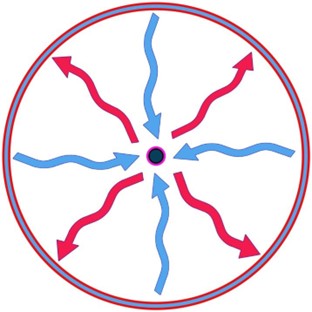.jpeg)
| Center & Circle |
Nadeau Sensei presents the combination of Center and Circle (or, Center Circle) as another expression of complementary partners that mutually activate and balance each other in our human system. He teaches that experiencing the subtle resonances of Center and Circle can lead to better physical, emotional, and energetic integration on the path of mind/body harmony.
To enhance our sense of Center and heighten our experience of Circle, Sensei offers a multistep process involving breath and chanting that he learned directly from Osensei as an Aikido training process, which can be practiced by anyone.
Standing with legs a little more than shoulder-width apart, knees slightly bent, open and settle to begin. Do several cycles of Centering practice with up/down energy flows while slowly raising and lowering both arms combined with deep breathing. Up/down and inhale/exhale are both primal expressions of the Two Beats of Creation. Let them synchronize naturally.

As illustrated in this diagram, this process will gradually activate the Center, which might be felt as subtle changes in posture, alignment, attitude, or vitality. First, slowly open both arms wider and wider, letting the energy of the Center expand outward in every direction until it reaches its natural limit, creating a sense of a Circle around you. Then, gradually lower your arms and let the energy of the Circle flow inward until it is absorbed back into the Center. Repeat several cycles, allowing yourself to ride the natural rhythm of the process until you internally feel the balancing of energies.

Center and Circle practice activates Two Beats of creative energy, as illustrated in the next diagram. One beat naturally flows outward from one’s center toward the circle, and the other beat naturally flows inward from the circle toward one’s center, creating a beneficial cycle of reciprocal energy flows that naturally activate and reinforce each other.
Next, add your voice to the ongoing cycles of arm movements and breath. The first chant he teaches uses two syllables, “Ahhh” and “Ohhh.” Let the sound “Ahhh” expand outward from your Center until it reverberates all around you and reaches its farthest limit. Inhale, then voice the sound “Ohhh” flowing inward toward your Center until it subsides of its own accord.
As the cycle continues, a sense of operational stability and a feeling of pulsing balance will gradually emerge, reverberating between “Ahhh” and “Ohhh,” between the outward flows and inward flows, between a fuller Center and an increasingly revealed Circle.
The Circle/Center chanting of “Ahhh” and “Ohhh” can be followed by another sequence using different sounds: “Ma-mi-mu-me-mo” and “Ya-yi-yu-ye-yo.”
This is still a Two-Beat process, but the multisyllabic chants can generate subtly different experiences. He tells students: “Play with it!” Allow the sounds to resonate through your body. Feel the harmonics as they vibrate within and without. Sense the effect on your Center. Experience the dimensionality of the Circle and its inherent connection to the Center.
Osensei taught that people are intrinsically oriented by their inner nature toward either Center or Circle as their preferred starting place. Therefore, the sound you start with or the syllable you chant is a matter of personal preference, as long as your Energy flows into and out from your Center. Students should start with what feels most natural to them, and stick with it consistently at first. Eventually, though, everyone should complement their initial preference by experiencing both Center and Circle.
By way of example, Nadeau Sensei describes himself as primarily a Center person who is naturally attracted to the power of up/down Energy flows and has had to work over the years on being more of a Circle person in terms of maintaining harmonious social relationships with the people around him. But he recognizes another person with more circular proclivities might not be as drawn to up/down exercises like bodybuilding with weights the way he was as a younger man. Instead, they might prefer walking in the woods where they feel energized and refreshed by the sense of space and aliveness all around them in the forest. But then they would find themselves needing to balance this with an improved capacity to stand up to pressure and get down to business when faced with deadlines, for example.
Ideally, a primarily Center person will develop the Circular qualities of their Character enough to find inner balance. Likewise, a primarily Circle person will develop the Center attributes of their Character sufficiently to find their inner balance.
When the up/down Energies of the Centered person are unified with the in/out Energies of the Circular person, one may feel a “doubling-up” of Energies being added and amplified. This incremental increase in the experience of Energies flowing through us is to be expected as a natural by-product of Circle/Center harmonization. But doubling-up can sometimes feel overwhelming, pushing even experienced students out of their bodies and into their heads where they think about the concept of surging Energies rather than experiencing them directly. Nadeau Sensei urges people not to be afraid when such doubling occurs. Instead, they should allow themselves to feel the qualities of the underlying Energies while continuing to Open and Settle even more to stay deeply rooted. As always, he teaches the importance of being Present while allowing things to unfold in their own time.
As an illustrative example of Center and Circle development, Nadeau Sensei describes how Morihei Ueshiba worked initially on strengthening his Center, beginning as a teenager who wanted to become physically stronger doing sumo exercises on the beach of his hometown of Tanabe, Japan. His experiences in the Japanese Imperial Army during the Russo-Japanese war when he was in his twenties developed him as a centered character, physically strong, dependable under pressure, and a natural leader. After the war, he went to Hokkaido with a group from Tanabe to carve the new village of Shirataki from the northern island’s vast forests, where he faced many new challenges that further strengthened his core. In Hokkaido, Morihei Ueshiba met Sokaku Takeda, master of Daito-ryu Jiujitsu, and further refined his Center through the rigorous practices of this traditional fighting art.
Later, he met the charismatic Onisaburo Deguchi, the artistically creative and extraordinarily gifted spiritual leader of Omoto-kyo, a new Japanese religion rooted in Shinto. Onisaburo recognized Morihei’s strongly centered character but urged him to develop the more circular aspects of his nature to cultivate a finer balance within himself. Onisaburo made such a strong impression that Morihei decided to live and train within the Omoto-kyo compound in the small town of Ayabe (near Kyoto) from 1922 to 1925.
Decades later, Osensei confided to Nadeau that during his time in Ayabe, Onisaburo was constantly “on his case” to more fully feel, sense, and experience Circle, and it was only when he did so that his extraordinary capabilities as Osensei—Great Teacher of Aikido—truly emerged.
.jpg)

Laurin began his Aikido training in 1971 as a student at Cornell University. Inspired by his first experience on the mat, he studied Japanese intensively, moved to Tokyo, and entered Aikido Hombu Dojo as an unranked white belt, earning his shodan there in 1976. He subsequently spent formative years at the Kumano Juku Dojo in Japan, training under Michio Hikitsuchi, Motomichi Anno, Motokazu Yanase, and Yasushi Tojima. Returning from Japan, he continued his practice with Terry Dobson and Ken Nisson at the Bond Street Dojo. After living in New York City, then Tokyo, then New York again, Laurin settled in the San Francisco Bay Area. He met Robert Nadeau in 1999 and has been training with him ever since. |
|
.jpeg)






.jpg)
